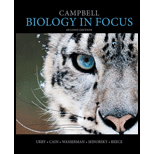
Concept explainers
Which structure or compartment is part of the symplast?
- A. the interior of a vessel element
- B. the interior of a sieve tube
- C. the cell wall of a mesophyll cell
- D. an extracellular air space
Introduction:
The symplast of a plant involve inner plasma membrane that facilitates diffusion of water and its solutes. The plasmodesmata forms the channel for the direct flow sugars, amino acids, and ions and other small molecules between cells. Transport of sugars is also occurs from mesophyll cells to sieve tubes through symplast.
The apoplastic pathway allows the molecules and water to move from epidermis to the cortex to reach endodermis. After reaching to endodermis, solutes are forced to choose symplastic pathway by the casparian strip. Solutes are filtered passively, and they reach to the pericycle and moved to the xylem for the transport to distant parts of the plant.
Answer to Problem 1TYU
Correct answer:
Sieve tube are the living that are tubular in shape and form a web by connecting the plant from end to end from the cortex of the root through the cytoplasm of the cells present in between the cells of root hair and the xylem and form the symplastic pathway. Therefore option (B) is correct.
Explanation of Solution
Reason for correct statement:
Phloem sap moves through the sieve tubes from a sugar source to the sugar sink via symplastic path or apoplastic path (depend on the species).
Option (B) is given as “the interior of a sieve tube”.
“Interiors of a sieve tube helps in maintain the sucrose and organic molecule concentration by active transport using symplastic pathway”, it is the right answer.
Hence, option (B) is correct.
Reasons for incorrect statements:
Option (A) is given as “the interior of a vessel element”.
The apoplastic pathway involves everything external to the plasma membrane that is the cell wall, interior portion of vessel elements and extracellular spaces. So, it is a wrong answer.
Option (C) is given as “the cell wall of the mesophyll cell”.
The cell wall of the mesophyll cell is a part of the apoplastic pathway. So, it is a wrong answer
Option (D) is given as “an extra cellular air space”.
As, the apoplastic pathway involves the extracellular spaces and tracheids. So, it is a wrong answer
Hence, options (A), (C), and (D) are incorrect.
The interior of a sieve tube is a part of symplast and helps in transport of sucrose from sugar source to sugar sink.
Want to see more full solutions like this?
Chapter 29 Solutions
Campbell Biology in Focus (2nd Edition)
Additional Science Textbook Solutions
Biological Science (6th Edition)
Chemistry: The Central Science (14th Edition)
Laboratory Manual For Human Anatomy & Physiology
SEELEY'S ANATOMY+PHYSIOLOGY
Biology: Life on Earth with Physiology (11th Edition)
- Not part of a graded assignment, from a past midtermarrow_forwardNoggin mutation: The mouse, one of the phenotypic consequences of Noggin mutationis mispatterning of the spinal cord, in the posterior region of the mouse embryo, suchthat in the hindlimb region the more ventral fates are lost, and the dorsal Pax3 domain isexpanded. (this experiment is not in the lectures).a. Hypothesis for why: What would be your hypothesis for why the ventral fatesare lost and dorsal fates expanded? Include in your answer the words notochord,BMP, SHH and either (or both of) surface ectoderm or lateral plate mesodermarrow_forwardNot part of a graded assignment, from a past midtermarrow_forward
- Explain in a flowcharts organazing the words down below: genetics Chromosomes Inheritance DNA & Genes Mutations Proteinsarrow_forwardplease helparrow_forwardWhat does the heavy dark line along collecting duct tell us about water reabsorption in this individual at this time? What does the heavy dark line along collecting duct tell us about ADH secretion in this individual at this time?arrow_forward
 Biology (MindTap Course List)BiologyISBN:9781337392938Author:Eldra Solomon, Charles Martin, Diana W. Martin, Linda R. BergPublisher:Cengage Learning
Biology (MindTap Course List)BiologyISBN:9781337392938Author:Eldra Solomon, Charles Martin, Diana W. Martin, Linda R. BergPublisher:Cengage Learning Concepts of BiologyBiologyISBN:9781938168116Author:Samantha Fowler, Rebecca Roush, James WisePublisher:OpenStax College
Concepts of BiologyBiologyISBN:9781938168116Author:Samantha Fowler, Rebecca Roush, James WisePublisher:OpenStax College
 Biology 2eBiologyISBN:9781947172517Author:Matthew Douglas, Jung Choi, Mary Ann ClarkPublisher:OpenStax
Biology 2eBiologyISBN:9781947172517Author:Matthew Douglas, Jung Choi, Mary Ann ClarkPublisher:OpenStax





